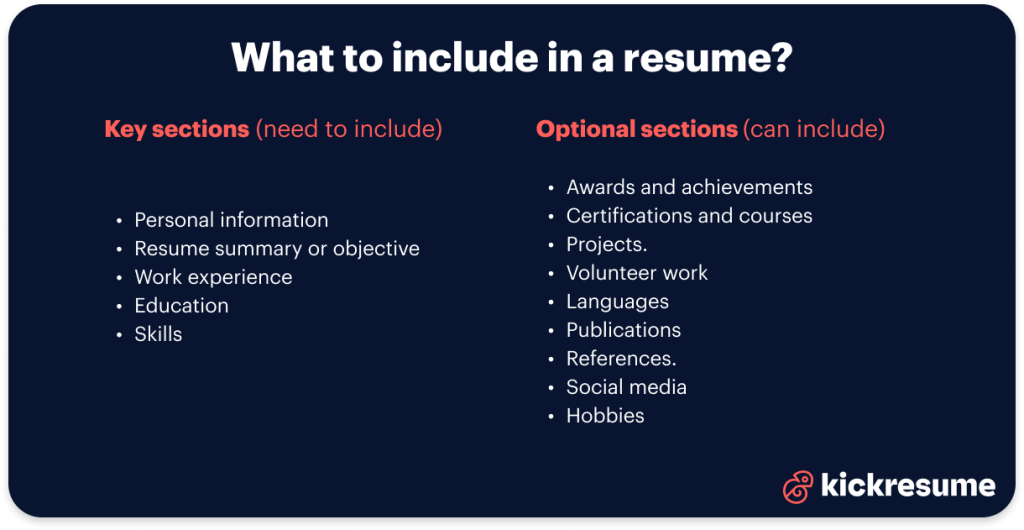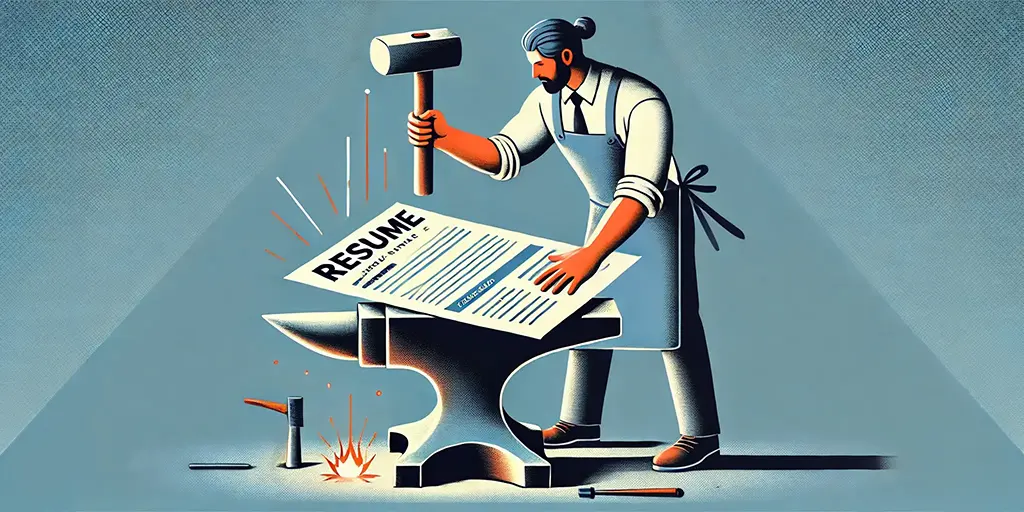What to include in a resume? It’s tempting to think that packing in every detail will impress the hiring manager, but an overloaded resume can backfire, making it harder for your key qualifications to stand out.
On the other hand, if you’re just starting out and don’t have much experience, you might find it challenging to fill your resume and decide what’s worth including.
The good news is that every resume, regardless of your industry or experience level, should contain 5 essential sections that no resume is complete without (though not necessarily in this order):
- Personal information
- Resume summary or resume objective
- Work experience
- Education
- Skills
Additionally, there are multiple optional sections you can include if they’re relevant to the job you’re applying for.
To help you craft the perfect resume, we’ll not only break down what to include in each section, but also provide examples for illustration.
Plus, we’ve included a guide on what to include in a high school resume if you’re just starting out.
What's necessary?
Resumes can look different depending on who's writing them.
- For example, a student’s resume is going to look a bit different from someone applying for a senior role with years of experience.
- Similarly, a social media manager’s resume won’t be the same as that of a front-end developer.
However, no matter your background or the job you’re applying for, there are a few essential rules to follow if you want a strong resume.
If you’re unsure what a strong resume should include, a great starting point is to focus on these five key sections which every resume has to include:
- Personal information
- Resume summary or resume objective
- Work experience
- Education
- Skills
These sections (though not necessarily in this order) should be included in every resume, regardless of your field or level of experience.
Now, let’s take a closer look at each of these key sections.
#1 Personal information section
Personal information section (also known as a resume header) should be at the top of your resume, as it introduces you to hiring managers with your essential contact details, like your name and email address. It's the first thing employers will look for.
What's included in the personal information section?
- Full name. Use your professional name.
- Phone number. Use the correct country prefix code.
- Email Address. Use a professional email address. Don't fill in your teenage and gaming emails. Also, don't use your email address from you previous job, it's not giving the best impression.
- LinkedIn Profile. Yes, you have to have LinkedIn at this point. Plus, they're going to look it up anyway.
There are also optional personal information you can include such as:
- Portfolio/Website. If it's relevant to your field (for instance in a creative industry), this will definitely help and usually, you will be asked to show one anyway.
- Social media. If your role involves online presence, like marketing or social media management, include relevant profiles (e.g., Instagram, X). Tech roles might benefit from adding GitHub to showcase projects.
- Picture. Though not necessary, a resume picture is customary in some countries.
#2 Professional summary or objective
First of all, a resume summary and resume objective are two different things.
But they do have something in common:
- Both sit at the top of your resume and are a few sentences (3-4) long
- Both serve as a short teaser for the rest of your resume
What's the difference between a resume summary and a resume objective?
- Resume summary. It's looking at the past–focuses on highlighting your experience, skills, and achievements. It’s tailored to the job you’re applying for and shows how your background makes you a strong candidate. This summary is often used by experienced candidates and professionals to show their qualifications and the value they bring to the role.
- Resume objective. It's looking at the future–focuses on your career goals and what you aim to achieve in the position you’re applying for. The purpose is to explain your career intentions and how this job aligns with your goals. Since it’s more forward-looking than a summary, it’s a good choice for first-time job seekers, career changers, and students.
Let's look at 2 examples–of a resume summary and objective, which will clear any confusion you might have left:
Resume summary example
Resume objective example
#3 Work experience
Work experience is definitely the most important part of your resume and usually the first thing recruiters check to see if you’re the right person for the job.
This section is where you highlight your past roles, responsibilities, the projects you worked on, and any achievements you accomplished along the way.
What to include in the work experience section?
- Company name
- Where it's located (city and country is enough)
- Job title
- Dates of employment
And, it doesn't stop there. You also want to include in each entry:
- Main tasks/what your focus was (1 bullet point). Start each bullet point with a strong action word, and use numbers whenever you can to show your impact. For example: “Managed a team of 8 marketing professionals, overseeing all campaign development and execution.”
- Show your accomplishments (2-3 bullet points). Quantify your results! For example, you could say, “Launched a social media campaign that grew the company's following by 30% in six months.”
- Show your problem-solving skills. If you lack concrete achievements, explain how you’ve solved a specific problem in the past with an example.
- Tailor this section to the job description. Do this by searching for any recurring keywords, skills, or experience mentioned in the job listing, and then explain how you’ve demonstrated that skill in your previous jobs.
#4 Education
The importance of the education section can vary depending on your level of experience and where you are in your career.
Regardless of your experience level, it's important to include this section in every resume, even if it's brief. It provides essential context and credentials that employers look for.
What to include in the education section?
- Name and location of your university
- Name of your degree or field of study
- The year when you started and graduated
If you're a recent graduate this section is likely going to be the core of your resume. In that case, don't forget to include also:
- Relevant coursework
- GPA (if higher than 3.5)
- Awards (Dean’s list, magna cum laude, subject-based awards)
- Scholarships
- Relevant student societies (especially if you were in the committee and played an active role)
- Academic publications
- Studying abroad
- Internships
- Thesis name and description
As with the work experience section, be specific, and focus on your highlights and moments where you learned the most.
#5 Skills
Every.resume.needs.a.skills.section!
Of course, your skills need to be sprinkled throughout your whole resume, but here you can highlight specific skills like using certain programs, certifications, or any technical training you’ve had.
What to include in skills section?
- Hard skills. These are the technical abilities you were taught. For example, programming languages or WordPress.
- Soft skills. These have to do with your personality. For example, collaboration, time-management, or dependability.
Alternatively, pick relevant skills and divide them into several subsections like computer skills, marketing skills, languages, and others.
Lastly, the number of skills you should list is between 5-15.

What's optional?
We covered the 5 key sections that shouldn't be missing in your resume. But, if you feel like you have something more to offer and it's relevant to your work, there are multiple optional sections that you can include in your resume.
In the list below you'll find what optional sections there are and what their point is in a resume.
Also, if you click on each respective headline, you'll find a more detailed guide on what to include in each of these.
Optional sections for your resume:
- Awards and achievements. Your achievements should be scattered throughout your entire resume. But, if you have enough content for this section, it will definitely help you to stand out.
- Projects. You can even create a separate projects section to list all kinds of (relevant) projects you've worked on. These can be academic, personal, work-related, freelance projects, etc.
- Certifications and courses. If it's relevant to your job then it can give you a big advantage because you are already certified for certain activities.
- Volunteer work. Including volunteering on your resume can help you stand out. It gives insight into your character and shows that you’re willing to go the extra mile. If you’re short on work experience, the volunteering section can be an excellent way to demonstrate your skills and experience.
- Language skills. You can include languages as a part of your hard skills. If you have extensive knowledge in other languages and it might help you stand out, you can create a specific section dedicated to languages.
- References. The references section on your resume contains a list of people who can vouch for you and provide your future employer with more information about your abilities.
- Publications. If you work in an academic field, publications and patents are a great achievement. Adding a list of publications can be a good step in elevating your resume.
- Hobbies. Our advice? Only include it if you have absolutely nothing else to put in your resume. In a more relaxed company, it might actually start a nice conversation later on.
What to include in a high school resume?
If you're a high school student or recent graduate trying to get into the job market but don't have much experience and aren’t sure what to include in your high school resume, don’t worry.
With a few easy adjustments, you can have a solid resume even if you're a first-time job seeker.
Here are some tips for creating a high school resume:
- Use a functional resume format. A functional resume (also referred to as skills-based resume) emphasizes your skills and abilities instead of your work history, which makes it a great option for high school students or first time-job seekers.
- Use a resume objective instead of a resume summary. Using a resume objective focuses on your goals and aspirations rather than on your work achievements.
- Put education section above experience. If you're a high school student, your education is the most important part of your life right now, so it should be the main focus of your resume. Take your time to put this section together carefully.
- Do include all of your skills. Include all the hard/computer skills you were taught in school. Also highlight any transferable skills you gained in your part-time jobs or while volunteering.
- Showcase other activities. Volunteering, clubs, and any other extracurricular activities can show your commitment and interests. It can be a great help with your first resume.
- Work experience (optional). If you have previous work experience, be sure to include it. However, if this is your first time seeking a job, focus more on your skills and education. With time, you'll gain experience to fill out this section.
Here's how a high school resume can look like (click directly on the resume to vie the full-length resume):
And if you want a little extra help, this is how you make a resume for your first job in 6 steps.
What to include in a resume? (Resume examples)
We covered all the sections and steps to help you create a strong resume, whether you are a professional with years of experience or a high school student.
Now, let's take a look at some resume examples. (Because you know... some people are simply more visual learners.)
FYI, these resumes were made using Kickresume’s templates. They belong to real people, which also means they were anonymised. Some of these are more than one page long, so click directly on the resume to vie the full-length resume.
What NOT to include in a resume
When writing a resume you have to make sure the information you're using is relevant and to the point. An unclear and messy resume can cost you a job.
Here are some things you definitely shouldn't include in your resume:
- Overly creative formatting. Your resume should be easy to navigate and read. The more complicated it is, the more likely a recruiter will move on to another resume.
- Unnecessary personal details. You want to avoid stating any unnecessary details like your age, marital status, full address, or religion. This information is not related to your job, so it's better if you keep it out.
- Outdated or irrelevant job experience. It can make your resume seem cluttered or give the impression that your career has stagnated. If you're not sure how many jobs to include, check out our article on how far back should a resume go.
- Salary information. This information can potentially exclude you from further interview process. This is something you should keep for the interview itself.
- Negative language or reasons for leaving jobs. This is a major red flag. Negative language on behalf of your former job makes you look unprofessional and leave an impression you are problematic.
- Typos and grammatical errors. Make sure your resume doesn't have any typos or grammatical errors, it gives an impression that you don't care and are imprecise.
Key takeaways: What to include in a resume?
So, what should you include in a resume? Let's sum everything up. All resumes, regardless of your industry or level of experience, should include 5 key resume sections:
- Personal information
- Resume summary or objective
- Work experience
- Education
- Skills
You can also include optional resume sections that will help your resume stand out, but only in case the sections you pick are relevant for the job:
- Certifications and licenses.
- Projects.
- Volunteer work.
- Awards and achievements.
- Language skills.
- Publications.
- References.
- Social media.
- Hobbies.
With that, you should be able to organize and build your resume in a way that will maximize your chances of landing a job. No matter how much experience you have.
Make sure to avoid any errors, negative language or unnecessary personal information and you should be good to go.
But, if you feel like you still need some help, you can create your resume using our resume builder tool.







